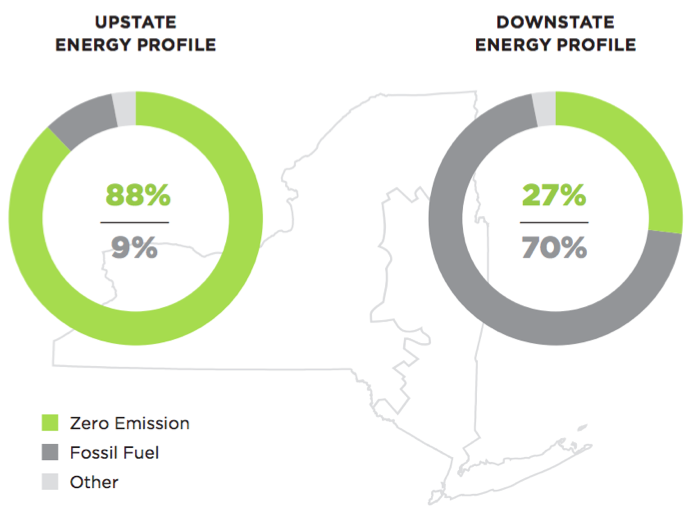Original publication by Urban Green Council • November 12, 2019
A look at the state of low-carbon energy in New York
In October 2019, Urban Green brought together leading experts at the Canadian Consulate to assess the state of low-carbon energy in New York and explore how the proposed Champlain Hudson Power Express project could help building owners comply with Local Law 97.
State of the grid
Two new policies enacted this year aim to drive major emissions reductions, in part through a cleaner grid. The Climate Leadership & Community Protection Act (CLCPA) sets a statewide goal of 70 percent renewable generation by 2030. Downstate, Local Law 97 places strict emissions caps on large buildings, which necessitates a lower-carbon grid and will increase demand for renewable energy credits (RECs) from green electricity flowing into NYC (Zone J).
But reducing grid emissions will become increasingly difficult as electricity demand grows. By 2040, demand in New York State is projected to increase by 36 percent, largely due to building electrification and electric vehicles. And according to Doug McMahon (New York Power Authority), “the peak demand for electricity in NYS will be three times what it is today.” So New York will need to reduce emissions while also increasing power supply, and “basically replace 60 percent of gas, coal, and oil electrons in the next 10 years,” said McMahon.
Generating green power is only part of the solution; the state must also develop the transmission capacity to deliver more renewables downstate. Currently, 88 percent of electricity in the upstate grid (Zones A-E) already comes from carbon-free sources, but downstate (Zones F-K) that figure drops to under 30 percent due to a bottleneck in the grid. With downstate offshore wind likely not coming online until the late 2020s, low solar deployment, and the impending closure of the 2-gigawatt Indian Point nuclear facility in 2021, it looks like the NYC grid will become more carbon-intensive before renewables come online.

Looking northward: Canada’s hydropower
This is where Hydro-Quebec’s renewable energy comes in, according to presenter Gary Sutherland (Hydro-Quebec). This public Canadian utility is the largest clean energy provider in North America, and already provides 8.6TWh of hydroelectricity to upstate New York each year (equivalent to ~1/6 of NYC’s electricity use). The utility has a track record of operating an extensive transmission system and is looking to export electricity from existing reservoirs. New York City, with its demand for continuous renewable energy, could be the perfect market… but the electricity must be able to get downstate first.
The Champlain Hudson Power Express, a 333-mile buried transmission line, is Hydro-Quebec’s proposed solution. The line is fully permitted and would deliver over 1,000 megawatts directly into Astoria, Queens. Sutherland noted, “We could replace probably half of Indian Point, fulfill up to 20 percent of NYC’s 2030 goal, and reduce New York City’s electricity emissions by 3 million metric tons.” The transmission line would deliver power to a million homes through two 5-inch diameter buried cables that avoid any form of intrusion to people or wildlife, noted Transmission Developers Inc. CEO Donald Jessome. Sutherland added that the project is “at a place where we essentially just need to work it out with New York City.”
No silver bullet solution
Event panelists Cecil Scheib (NYU), Peter Ross (Hodgson Russ LLP) and Joseph O’Brien-Applegate (Pace Energy and Climate Center) agreed that the prospect of the new transmission line was exciting, but emphasized that even if the transmission line is built, renewables must also be deployed downstate en masse. And finding an adequate supply of green power is not the only solution: there is still tremendous potential to reduce demand through improved efficiency, load shifting, and user behavior. “The cleanest, most cost-effective electrons are the ones we don’t use,” said McMahon. And cutting demand is doable, according to Scheib, chief sustainability officer for NYU, one of the largest building owners in NYC. The University has already cut emissions 30 percent by taking steps that any other building in the city can implement, said Scheib.
While the goals set forth by the CLCPA and Local Law 97 are ambitious, panelists believe they’re achievable. Intermittent renewables, such as wind and solar, will have to be balanced with dispatchable carbon-free sources, such as Hydro-Quebec’s hydropower. NYC’s transmission system will need to be brought into the 21st century to allow more renewable energy to flow to where it’s needed. And building owners and tenants will have to alter both their behavior and building systems. The transition to a greener grid is just beginning, and Urban Green will continue to push the conversation forward on this critical topic. Stay tuned for further programming, including our 2020 Conference, which will tackle solutions to unlocking more renewables in NYC.
Further Reading
New green power in NYC: A conversation with Tier 4 winners
How will Tier 4 bring New York's electrical grid clean, renewable energy?
Hydro’s potential in a zero carbon future (w/ Sophie Brochu)
Join Sophie and John as they discuss how NYC can utilize hydropower to reduce carbon emissions.